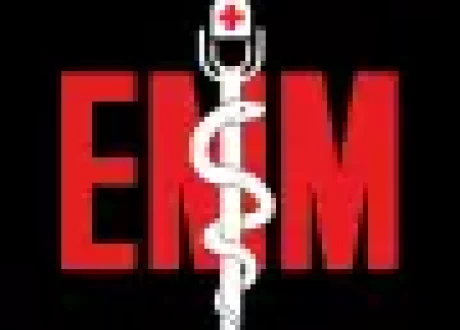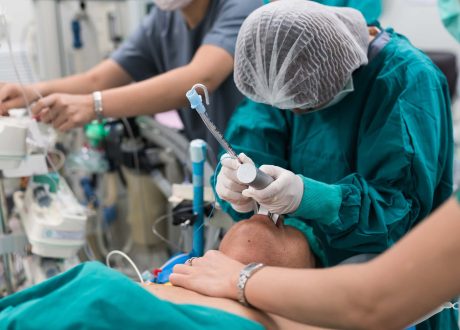 http://orcid.org/0000-0001-6857-1430Fiona Chen, http://orcid.org/0000-0001-8896-7512Emily Neill, Sally Graglia Correspondence to Dr Fiona Chen, Department of Emergency Medicine, University of California San Francisco, San Francisco, California, USA; Fiona.Chen@ucsf.edu
http://orcid.org/0000-0001-6857-1430Fiona Chen, http://orcid.org/0000-0001-8896-7512Emily Neill, Sally Graglia Correspondence to Dr Fiona Chen, Department of Emergency Medicine, University of California San Francisco, San Francisco, California, USA; Fiona.Chen@ucsf.edu
Case presentation 
A 57-year-old man with a history of recently diagnosed diabetes mellitus presented to the ED with 2 weeks of perineal pain and swelling. He was seen at an urgent care centre approximately 1 week prior to presentation, where he was diagnosed with cellulitis and prescribed trimethoprim-sulfamethoxazole. A few days prior to presentation to the ED, the swelling had increased significantly and was now associated with chills, diaphoresis and purulent drainage.
On physical examination, the patient is uncomfortable-appearing with vital signs notable for tachycardia at 104 beats per minute and tachypnoea at 22 breaths per minute; however, he is afebrile at 37.1°C. The penis appears normal without significant tenderness to palpation, however the inferior scrotum and perineum are diffusely swollen and tender to palpation, with erythema tracking superiorly towards the inguinal ring and areas of necrosis with foul-smelling purulent drainage (figure 1).
Laboratory workup was notable for a leucocytosis of 14.9×109/Lm, hyponatremia with sodium of 132 mmol/L and blood glucose of 0.556 mmol/L with HbA1c of 11.0. He is acidotic with a pH of 7.28 on venous blood gas and has a lactate of 4.4. Point-of-care ultrasound (POCUS) demonstrates copious subcutaneous emphysema highly concerning for a necrotising infection.
What are the indications for performing POCUS for necrotising fasciitis?
POCUS is an invaluable tool in the diagnosis and management of a number of skin and soft tissue infections (SSTIs) including cellulitis, abscess and necrotising fasciitis. Necrotising fasciitis, colloquially known as ‘flesh-eating’ bacterial infections, are rare, life-threatening infections that result in the death of muscle fascia and subcutaneous tissue. Fournier gangrene is a subset of necrotising fasciitis characterised by an acute necrotic infection of the penis, scrotum or perineum, with reported morbidity and mortality between 15% and 50%.1 Prompt diagnosis and treatment with early surgical intervention is crucial in order to minimise complications from this life-threatening infection.2
Early necrotising SSTIs are often subtle in their presentation and may present similarly to erysipelas, cellulitis or abscess, with erythema, swelling and tenderness on exam. As the disease progresses, there may be more overt signs, such as crepitus or drainage of grey, watery ‘dishwater fluid’ from the affected site.3 Clinical decision tools, such as the Laboratory Risk Indicator for Necrotising Fasciitis Score, have been developed to support clinicians in diagnosis, but these tools have poor sensitivity (59.2%) and specificity (83.8%) with limited external validity.4 5 CT and MRI have reported sensitivities for necrotising fasciitis between 80% and 100%, however, these modalities can be costly and time-consuming and should not delay care in the critically ill or septic patient.6 7
POCUS is an efficient, portable tool that can be used at the bedside in combination with physical exam, laboratory data and advanced imaging to evaluate for necrotising fasciitis. POCUS can also help clinicians prioritise or expedite additional advanced imaging. In this case, there was a high index of suspicion for Fournier gangrene given the failure of outpatient antibiotics and rapid progression of infection. POCUS was used to rapidly confirm the diagnosis, expedite additional imaging and consult the surgical team.
There are no true contraindications to performing POCUS for necrotising fasciitis. Care should be taken to avoid contaminating the ultrasound transducer or introducing a new contaminant to the skin by using a probe cover or other barrier between infected skin and the transducer.
Which transducer is best suited for performing POCUS for necrotising fasciitis?
Because the structures imaged in skin and soft tissue ultrasounds are often superficial, the linear array transducer (6–13 mHz) is ideal as it provides the highest resolution in evaluating superficial structures such as skin, subcutaneous tissue, fascia and sometimes muscle.8 9 In patients with larger body habitus, lower frequency probes, including the curvilinear probe (2–5 mHz), may be used in order to visualise deeper structures as necessary.8
Which views should be obtained when assessing for necrotising fasciitis?
For all soft tissue ultrasound, the examiner should initially place the high-frequency linear probe in an unaffected area of soft tissue and then scan towards the area of interest. This allows the examiner to perform in vivo comparison of affected and unaffected tissue. The examiner should evaluate the area of interest in two orthogonal planes (eg, transverse and longitudinal) to fully visualise the structures.8 In this patient, images were taken of the scrotum, both with and without images of the testicles, the bilateral thighs to help define the extent of involvement, and the mons pubis area.
For soft tissue ultrasound, it is important to be familiar with a number of key structures that should be visualised on exam. The most superficial layers, epidermis and dermis, appear as thin hyperechoic (bright white) bands at the top of the screen. This may be followed by layers of hypoechoic (darker) fat and hyperechoic connective zones of subcutaneous tissue. Occasionally, this tissue may contain nerves or anechoic (black) vascular structures. Fascia will appear as thin hyperechoic lines surrounding the muscle (hypoechoic striated bands). Figure 2 labels the skin, subcutaneous tissue, fascia and muscle layers in an area of unaffected soft tissue.
Distortion of this architecture can often be indicative of pathology. The evaluation for necrotising soft tissue infections relies on the identification of abnormal findings in the subcutaneous tissue and fascial layers.
In this case, POCUS images were obtained of the patient’s unaffected lateral thigh (figure 2), testicles (figure 3) and posterior scrotum/perineum (figure 4). Figure 2 shows normal soft tissue, with no areas of cobblestoning (hypoechoic fluid separating subcutaneous tissue and fat in a reticular pattern, representing soft tissue oedema, a finding characteristic of cellulitis) or gas. Figure 3 shows normal-appearing testes. The testes are often spared in Fournier gangrene due to their independent blood supply: the testicles receive blood from the testicular artery, separate from the rest of the surrounding skin and soft tissue of the perineum, which receives blood from the pudendal artery.10 Figure 4 was the concerning sonographic image discussed below.
How do you interpret POCUS for necrotising fasciitis?
POCUS for necrotising fasciitis should focus on identifying the signs of SSTI as well as the presence of free air within the tissue, which is highly suspicious for a necrotising infection. Surrounding structures should also be evaluated to assess their involvement in any infectious or inflammatory process.
After viewing normal structures, attention should be turned towards evaluating for subcutaneous emphysema and air, represented by hyperechoic ‘comma shaped’ structures with posterior shadowing and reverberation artefact.
The key findings on ultrasound can be summarised using the STAFF mnemonic (subcutaneous thickening, air, and fascial fluid), and examination for these findings has been proposed as a means of rapidly evaluating for a necrotising SSTI.11 Measurement of the perifascial fluid has also been used as a diagnostic tool, with fluid collections >4 mm being suggestive of this type of infection.12
The presence of gas on soft tissue ultrasound should always sound the alarm for a necrotising infection and should prompt the clinician to obtain further laboratory and/or imaging studies in consideration of prompt antibiotic administration and urgent surgical evaluation.
What is the interpretation of this patient’s ultrasound?
In this case, as the probe is moved inferiorly towards the perineum, innumerable small hyperechoic areas are visualised. These hyperechoic areas have posterior acoustic shadowing, an artefact in which a structure that strongly absorbs or reflects ultrasound waves casts a ‘shadow’ deep to that structure.13 This is representative of gas within the tissue, a pathognomonic finding for necrotising fasciitis in the right clinical setting (figure 4).14 It is important to note that patients who have had recent surgical instrumentation and those who are injection drug users may also have air that can be visible on ultrasound. This patient denied history of either, and thus, the finding of subcutaneous air on ultrasound was highly suspicious for Fournier gangrene.
Air, when visualised on ultrasound, has a hyperbright appearance due to its low acoustic impedance.15 The sound waves generated by the ultrasound fail to penetrate through the air and are reflected back towards the probe, limiting the evaluation of structures deep to the gas and creating the posterior acoustic shadowing and reverberation artefact described above.
The included video clip (online supplemental video) not only highlights the presence of gas within the tissue, but also demonstrates bubbles of gas moving through fluid.
Supplementary video
What is the evidence for using POCUS for necrotising fasciitis in clinical practice?
There is robust and growing evidence to support the use of POCUS in the evaluation of SSTIs. Skin and soft tissue ultrasound is included in the American College of Emergency Physicians curriculum and the data obtained from ultrasound has been shown to guide treatment decisions, particularly in cases of clinically diagnosed cellulitis.16 17
For necrotising fasciitis, sonography has been shown to have high sensitivity and specificity at 88% and 93%, respectively.18
There are a number of benefits to augmenting the physical examination with sonography. Ultrasound is a non-invasive diagnostic tool that can be performed at the bedside, does not require intravenous access, does not expose the patient to ionising radiation or contrast media, and can be readily replicated. In resource-limited settings, POCUS is a portable and cost-effective means of rapid diagnosis that also provides real-time feedback on resuscitative efforts and procedural guidance.
While cross-sectional imaging may be most sensitive and specific and is the gold standard imaging of necrotising infections, the ubiquity of POCUS in the ED facilitates the prompt administration of antibiotics and early surgical consultation of a time-dependent and highly morbid disease.
What are expert tips when performing POCUS for necrotising fasciitis?
When evaluating for skin and soft tissue changes on POCUS, it is important to scan beyond the reported area of pain, swelling or overlying skin change. Whether it is scanning the contralateral extremity or placing the probe proximally or distally to the area of interest, initiating the exam by visualising normal tissue can help the operator detect more subtle changes in the key structures and layers. This baseline exam will also help familiarise the novice sonographer with the appearance of normal tissue layers in patients with varying habitus.
It is also important to optimise the depth of the ultrasound image. While shallow images often have higher resolution on the screen, abnormal findings may only be seen deeper to the initial image on the linear probe and the depth of penetration should be adjusted to interrogate all of the tissue of interest.
What are some of the pitfalls of POCUS for necrotising fasciitis?
While ultrasound can be used to evaluate skin and soft tissue for signs concerning for necrotising fasciitis, the absence of these findings cannot be used to rule out the diagnosis.
In some instances, the evaluation of deeper structures may be limited by the presence of superficial findings such as cobblestoning, which can be seen in uncomplicated cellulitis.9 12 The presence of cobblestoning can inhibit visualisation of deeper structures.19
It is also important to note that sonographic findings of necrotising soft tissue infections fall on a spectrum. While this case serves to highlight some of the more striking findings of Fournier gangrene, other cases may be more understated.7 Thus, the interpretation of POCUS imaging for SSTIs, including Fournier gangrene, should be used in conjunction with other diagnostic modalities.
Because of the high morbidity and mortality associated with Fournier gangrene and other necrotising soft tissue infections, use of bedside ultrasonography should never delay definitive management with surgical debridement. However, the point-of-care nature of bedside ultrasound permits its incorporation into the existing flow of patient care in the ED, such as during initial physical exam. As POCUS becomes more widely available in EDs, its use in tandem with advanced imaging, antibiotics and surgical consultation can help clinch the diagnosis and expedite care.
Case conclusion
POCUS images were collected over 10 min while the patient was in queue for CT. Cross-sectional imaging demonstrated extensive subcutaneous gas, fluid, and oedema in the left scrotum and anterior abdominal subcutaneous tissue, which was concerning for Fournier gangrene. No organised or rim-enhancing collections were detected.
The patient was initiated on broad-spectrum antibiotics and taken to the operating room by General Surgery and Urology for urgent perineal, perianal and inguinal debridement. Intraoperative cultures grew Enterococcus faecalis and Streptococcus anginosus. He had a prolonged hospitalisation with serial debridements of necrotic tissue. Ultimately, the patient was discharged home on hospital day 16 with outpatient surgical follow-up and is recovering well.













